
Clearing a Locked Session
If you have changed the RSCN timer configuration and have forgotten to release the lock by either committing
or discarding the changes, an administrator can release the lock from any switch in the fabric. If the administrator
performs this task, your changes to the pending database are discarded and the fabric lock is released.
The pending database is only available in the volatile directory and are subject to being discarded if the switch
is restarted.
To use administrative privileges and release a locked DPVM session, use the
clear rscn session vsan
command
in EXEC mode. This example shows how to clear the RSCN session for VSAN 10:
switch#
clear rscn session vsan 10
Displaying RSCN Configuration Distribution Information
This example shows how to display the registration status for RSCN configuration distribution:
switch#
show cfs application name rscn
Enabled
: Yes
Timeout
: 5s
Merge Capable
: Yes
Scope
: Logical
A merge failure results when the RSCN timer values are different on the merging fabrics.
Note
This example shows how to display the set of configuration commands that would take effect when you
commit the configuration:
The pending database includes both existing and modified configuration.
Note
switch#
show rscn pending
rscn event-tov 2000 ms vsan 1
rscn event-tov 2000 ms vsan 2
rscn event-tov 300 ms vsan 10
This example shows how to display the difference between pending and active configurations:
switch#
show rscn pending-diff vsan 10
- rscn event-tov 2000 ms vsan 10
+ rscn event-tov 300 ms vsan 10
Default Settings for RSCN
The following table lists the default settings for RSCN.
Table 28: Default RSCN Settings
Default
Parameters
2000 milliseconds for Fibre Channel VSANs
RSCN timer value
Disabled
RSCN timer configuration distribution
Cisco Nexus 5500 Series NX-OS SAN Switching Configuration Guide, Release 7.x
OL-30895-01
197
Managing FLOGI, Name Server, FDMI, and RSCN Databases
Default Settings for RSCN
















































